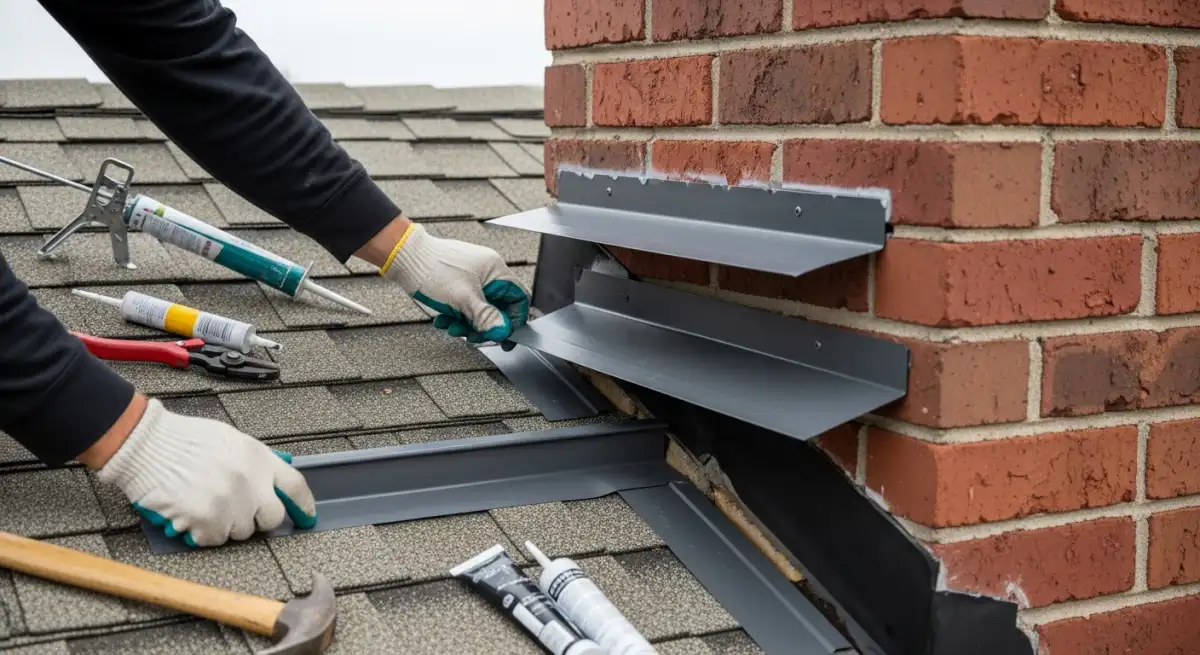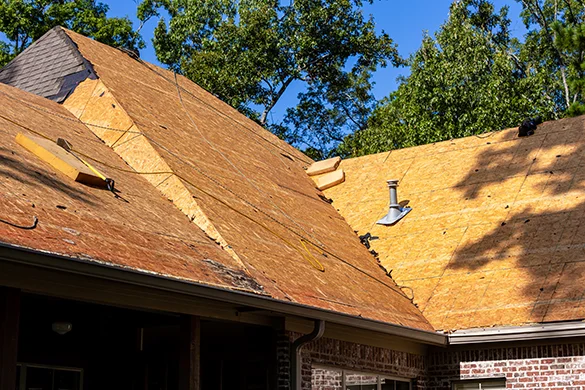Roof Leaks and Mold: When to Call a Mold Remediation Company Near You
Roof leaks create the perfect conditions for mold growth—darkness, moisture, and organic materials combine in attic spaces and wall cavities to support rapid fungal proliferation that threatens both property and health. Northern Virginia's humid climate accelerates mold development following even minor leaks, making prompt detection and professional remediation critical. Understanding the connection between roof damage and mold growth, recognizing when DIY cleaning becomes inadequate, and knowing when to search for a mold remediation company near you protects families from health hazards while preventing thousands in structural damage throughout Reston, Herndon, and surrounding communities.
How Roof Leaks Trigger Mold Growth
Mold spores exist everywhere in outdoor and indoor environments, remaining dormant until encountering ideal growth conditions. Roof leaks provide exactly what mold needs—moisture, organic food sources like wood sheathing and insulation, comfortable temperatures, and darkness. Within 24-48 hours of water intrusion, mold colonies begin establishing themselves. Within days, visible growth appears on affected surfaces while invisible spores spread through air circulation systems.
The connection between roofing problems and mold often remains hidden until substantial damage occurs. Slow leaks from deteriorated flashing, damaged shingles, or ice dam backup introduce moisture gradually without obvious interior signs. Water travels along rafters and sheathing, saturating insulation and creating widespread mold growth before homeowners notice ceiling stains or musty odors. This hidden damage makes addressing leaking roof repairs quickly essential for preventing mold establishment.
Common Roof Leak Sources Leading to Mold
Missing or damaged shingles create obvious entry points for water infiltration. Wind-driven rain penetrates beneath compromised shingles, soaking underlayment and decking. Storm damage from falling branches, hail impact, or severe winds frequently causes these vulnerabilities. Without prompt repair, even small shingle damage allows continuous moisture intrusion supporting extensive mold colonies.
Flashing failures around chimneys, skylights, and roof penetrations represent another major mold contributor. Deteriorated sealant, corroded metal, or improper installation allows water to bypass roofing materials and directly access interior spaces. These leak sources prove particularly insidious because they may only activate during heavy rainfall or ice dam conditions, creating intermittent moisture that perpetuates mold growth cycles. Professional inspection identifies these vulnerabilities before they escalate into major repair needs.

Ventilation and Condensation Issues
Poor attic ventilation creates condensation that mimics leak symptoms while promoting mold growth even without actual roof failures. Inadequate soffit or ridge vents trap warm, moist air in attic spaces. When this humidity contacts cold roof decking during winter, condensation forms—creating wet conditions identical to those from leaks. Mold thrives in these persistently damp environments, spreading across rafters, sheathing, and insulation.
Bathroom and kitchen exhaust fans venting into attic spaces compound problems by introducing moisture-laden air directly to mold-prone areas. Proper ventilation routes this humidity outdoors while maintaining attic air circulation preventing condensation. Addressing ventilation deficiencies alongside leak repairs ensures comprehensive mold prevention strategies rather than temporary fixes that allow recurrence.
Health Risks Associated with Mold Exposure
Mold exposure causes serious health effects ranging from minor irritation to severe respiratory conditions. Common symptoms include nasal congestion, throat irritation, coughing, wheezing, and eye irritation. Individuals with asthma or mold allergies experience intensified reactions including breathing difficulties and asthma attacks. Prolonged exposure to certain mold types—particularly black mold (Stachybotrys chartarum)—may cause more severe health issues including chronic respiratory problems, neurological symptoms, and immune system suppression.
Children, elderly individuals, and those with compromised immune systems face heightened vulnerability to mold-related health effects. Even healthy adults experience symptoms when exposure levels rise sufficiently. The insidious nature of mold growth means families often breathe spores for months before connecting health symptoms to hidden roof leak damage. This connection makes searching for a mold remediation company near me urgently important when musty odors or visible growth appear anywhere in homes.
Recognizing Signs of Mold in Your Home
Musty, earthy odors represent the most common early mold indicator—even when visual growth remains hidden. These smells concentrate in specific rooms or areas, particularly near ceiling corners, closets, or basement areas beneath roof leaks. Persistent odors despite cleaning efforts signal hidden mold colonies requiring professional investigation.
Visible mold appears as black, green, white, or orange patches on walls, ceilings, wood surfaces, or insulation. Discoloration may appear fuzzy, slimy, or powdery depending on mold type and growth stage. Water stains on ceilings or walls—even if currently dry—indicate past or intermittent moisture problems that likely support mold growth. Peeling paint, warped wood, or crumbling drywall suggest moisture damage and probable mold presence requiring immediate attention from professionals experienced in both roof repairs and mold remediation.

Testing and Confirmation
Mold testing confirms suspicions when odors or health symptoms suggest problems but visible growth remains elusive. Professional mold inspectors use moisture meters identifying damp areas, infrared cameras revealing hidden water damage, and air quality tests measuring spore concentrations. Surface samples collected from suspected growth areas undergo laboratory analysis identifying specific mold species and contamination severity.
DIY mold test kits provide limited value compared to professional assessment. These home tests often produce false positives from normal environmental mold while missing dangerous species or failing to identify contamination sources. Professional testing costs $300-800 but provides actionable information about contamination extent, species identification, and remediation requirements—information essential for protecting health and planning effective treatment strategies.
When DIY Mold Cleanup Becomes Inadequate
Small mold patches covering less than 10 square feet on non-porous surfaces may suit DIY cleaning using household solutions. Bathroom tile mold, minor window condensation growth, or small affected areas respond to scrubbing with detergent and water followed by thorough drying. These limited situations require proper protective equipment—gloves, goggles, and N95 respirators—even for small-scale cleaning to prevent spore inhalation.
However, most mold resulting from roof leaks exceeds safe DIY remediation scope. Growth affecting porous materials like drywall, insulation, or wood requires removal rather than cleaning since mold penetrates these materials beyond surface access. Contamination exceeding 10 square feet, growth in HVAC systems, or situations involving sewage or contaminated water demand professional intervention. Attempting DIY remediation in these circumstances spreads spores throughout homes while failing to address underlying moisture sources—creating recurring problems worse than initial contamination.
What Professional Mold Remediation Companies Do
Professional mold remediation follows established protocols ensuring complete removal while preventing spore spread. The process begins with comprehensive inspection identifying all affected areas and contamination sources. Professionals establish containment using plastic sheeting and negative air pressure preventing spore migration to clean areas during removal. HEPA filtration systems continuously clean air, capturing microscopic spores released during remediation work.
Contaminated materials undergo careful removal and disposal following safety regulations. Porous materials like drywall and insulation require complete replacement while non-porous surfaces receive specialized cleaning and antimicrobial treatment. After removal, affected areas receive thorough cleaning, drying, and treatment preventing recurrence. Final air quality testing confirms successful remediation before reconstruction begins. This systematic approach ensures complete mold elimination impossible through DIY methods, particularly for extensive contamination resulting from prolonged roof leaks.

Choosing the Right Mold Remediation Company Near Me
Selecting qualified mold remediation professionals protects both health and property investment. Verify certifications from organizations like the Institute of Inspection, Cleaning and Restoration Certification (IICRC) or the National Organization of Remediators and Mold Inspectors (NORMI). These credentials demonstrate professional training in proper remediation protocols, safety procedures, and industry standards. Licensed contractors carry appropriate insurance protecting homeowners from liability during remediation work.
Request detailed written estimates outlining work scope, specific procedures, timeline, and costs. Quality contractors explain their process, answer questions thoroughly, and provide references from similar projects. Avoid companies offering unusually low bids or those pressuring immediate decisions without proper inspection. The best mold remediation company near me provides transparent communication, follows established protocols, and coordinates with roofing contractors addressing moisture sources preventing mold recurrence.
Cost Factors for Mold Remediation
Mold remediation costs vary significantly based on contamination extent, location accessibility, and required repairs. Small projects affecting single rooms typically range $500-1,500 for professional treatment. Moderate contamination spanning multiple areas costs $1,500-4,000 depending on material removal requirements. Extensive mold from long-term roof leaks affecting entire attics, multiple rooms, or HVAC systems can reach $10,000-30,000 or more.
Additional costs include post-remediation reconstruction—replacing removed drywall, insulation, and flooring. Roof repairs addressing moisture sources add $500-5,000 depending on damage extent. Air quality testing before and after remediation costs $300-800. While these expenses seem substantial, they pale compared to health costs from continued exposure or property value loss from unaddressed contamination. Many homeowners insurance policies cover mold remediation when resulting from covered perils like sudden roof damage, making insurance documentation essential.

Insurance Coverage Considerations
Homeowners insurance typically covers mold remediation when resulting from sudden, accidental water damage like storm-related roof leaks. Policies generally exclude mold from gradual leaks, maintenance neglect, or flood damage. Coverage limits for mold often cap at $1,000-10,000 regardless of total remediation costs. Understanding policy specifics before problems arise helps homeowners plan financially and document claims properly.
Successful insurance claims require thorough documentation including photos of damage, professional assessment reports, and detailed remediation estimates. Report roof leaks and water damage immediately—delays suggesting neglect may jeopardize coverage. Work with remediation companies experienced in insurance processes who can provide necessary documentation supporting claims. Some situations benefit from public adjusters who negotiate with insurance companies on homeowners' behalf, ensuring fair settlements covering legitimate remediation expenses.
Preventing Mold Growth from Roof Issues
Proactive roof maintenance represents the most effective mold prevention strategy. Annual professional inspections identify vulnerable areas before leaks develop. Prompt repair of damaged shingles, flashing, or penetration seals prevents water intrusion. Maintaining clean gutters ensures proper drainage preventing ice dams and water backup. These preventive measures cost far less than addressing mold contamination and structural damage from neglected maintenance.
Adequate attic ventilation prevents condensation-related mold even when roofs remain watertight. Soffit and ridge vents should provide 1 square foot of ventilation per 300 square feet of attic space. Ensure bathroom and kitchen exhaust fans vent outdoors rather than into attics. Install vapor barriers in appropriate locations preventing moisture migration into building cavities. Address these ventilation factors during roof replacement projects ensuring comprehensive protection against moisture problems.
Immediate Actions After Discovering Roof Leaks
Quick response to roof leaks minimizes mold risk significantly. Place containers catching dripping water and move valuables away from affected areas. Use fans and dehumidifiers reducing moisture levels in impacted spaces. Document damage with photos for insurance purposes. Contact roofing professionals for emergency repairs preventing continued water intrusion.
Within 24-48 hours, arrange professional roof inspection and repair. This critical window prevents mold establishment while damage remains limited. Remove wet insulation, carpeting, or other porous materials that cannot be thoroughly dried within this timeframe. These immediate actions—combined with professional roof repairs and monitoring for mold signs—provide the best protection against contamination requiring expensive remediation. Northern Virginia homeowners in Vienna, McLean, and surrounding areas benefit from establishing relationships with qualified roofing and remediation professionals before emergencies occur.

Long-Term Monitoring
Following roof leak repairs and any necessary mold remediation, continued monitoring ensures problems do not recur. Regularly inspect previously affected areas for new water stains, odors, or visible growth. Check attic spaces quarterly examining for condensation, water stains, or mold indicators. Maintain humidity levels below 50% using dehumidifiers in problematic areas. These monitoring practices identify emerging issues before they escalate into major contamination.
Document all roof maintenance, repairs, and inspections. This record helps identify patterns, supports warranty claims, and provides valuable information for future contractors or home buyers. Schedule professional roof inspections every 1-2 years, more frequently following severe weather. Regular maintenance contracts with qualified roofing companies ensure consistent monitoring while preventing the neglect that allows small problems to become costly disasters requiring both roof replacement and extensive mold remediation.
Coordinating Roof Repairs with Mold Remediation
Successful mold elimination requires addressing both contamination and moisture sources simultaneously. Mold remediation without roof repairs guarantees recurrence—new water intrusion recontaminates cleaned areas within weeks. Conversely, roof repairs alone leave existing mold spreading spores and threatening health. Coordinate both services ensuring moisture elimination before remediation and preventing recontamination during reconstruction.
Quality roofing contractors work with remediation specialists coordinating repairs. Roof work typically proceeds first, eliminating water intrusion and allowing affected areas to dry. Remediation follows, removing contaminated materials and treating affected surfaces. Finally, reconstruction restores damaged areas using mold-resistant materials and proper moisture barriers. This sequenced approach—standard practice among experienced professionals—ensures complete problem resolution rather than temporary fixes requiring repeated intervention.
Northern Virginia Climate and Mold Challenges
Northern Virginia's humid subtropical climate creates ideal conditions for mold growth following roof leaks. Summer humidity regularly exceeds 70%, maintaining moisture levels supporting rapid mold proliferation. Frequent thunderstorms test roof integrity while providing moisture driving contamination. Winter freeze-thaw cycles damage roofing materials creating leak pathways, while ice dams force water beneath shingles into attic spaces.
These regional climate factors make proactive roof maintenance and prompt leak response especially critical for area homeowners. Mold establishes faster in humid conditions than in arid climates—what might take weeks elsewhere happens in days here. Local building practices evolved addressing these challenges through improved ventilation standards, moisture-resistant materials, and aggressive maintenance schedules. Working with contractors experienced in Northern Virginia conditions ensures appropriate solutions rather than generic approaches inadequate for local climate demands.

Protecting Property Value Through Prevention
Mold contamination severely impacts property values and sale prospects. Buyers increasingly demand mold inspections before purchase, and discovery of contamination kills deals or forces substantial price reductions. Even successfully remediated mold requires disclosure in many jurisdictions, affecting buyer confidence. Properties with visible mold or musty odors become unmarketable until properly addressed through professional remediation and source correction.
Preventing mold through diligent roof maintenance protects investments while avoiding disclosure complications. Regular inspections, prompt leak repairs, and proper ventilation cost far less than remediation while maintaining property appeal. Homeowners planning to sell within 5-10 years particularly benefit from aggressive prevention—avoiding the discovery of problems during pre-sale inspections that derail transactions or force expensive emergency remediation under time pressure from pending closings.
Questions to Ask Mold Remediation Companies
Informed homeowners ask specific questions ensuring qualified professional selection. Essential inquiries include: What certifications and training do your technicians hold? How long have you operated in Northern Virginia? Can you provide references from similar mold remediation projects? What specific protocols do you follow during remediation? How do you prevent spore spread during work?
Additional critical questions address scope and guarantees: Will you identify and help address moisture sources causing mold? What testing do you perform before and after remediation? Do you provide written guarantees against recurrence? Are you insured and licensed for remediation work? How do you handle unexpected contamination discovered during work? These questions reveal company professionalism and help homeowners select the best mold remediation company near me for their specific situation. Quality contractors welcome detailed questions and provide thorough, transparent answers demonstrating expertise and commitment to proper remediation practices.

Red Flags to Avoid
Certain warning signs indicate unqualified or unethical mold remediation contractors. Avoid companies offering free mold testing—legitimate testing costs money, and "free" services often represent sales tactics inflating remediation needs. Reject contractors who diagnose extensive mold requiring immediate treatment without proper inspection and testing. Beware of scare tactics exaggerating health risks or claiming toxic mold emergencies demanding instant decisions.
Additional red flags include contractors lacking proper insurance, certifications, or business licenses. Avoid companies requesting large upfront deposits before work begins—standard practice involves progress payments tied to completion milestones. Reject contractors who cannot provide detailed written estimates, references, or proof of training. These warning signs often indicate inexperienced operators or scammers who take money without delivering proper remediation, leaving homeowners with continuing problems and depleted budgets preventing correction by qualified professionals.
Ready to Address Roof Leaks and Mold Concerns?
Roof leaks and mold represent serious threats to both property and health, demanding prompt professional attention when problems arise. Understanding the connection between roof damage and mold growth, recognizing when DIY approaches prove inadequate, and knowing how to select qualified remediation professionals protects Northern Virginia families from health hazards while preserving home values. Proactive roof maintenance prevents these problems before they start—the most effective and economical approach to mold protection.
Reston Roof provides comprehensive roofing services addressing leak sources before they trigger mold contamination. Our experienced team identifies vulnerable areas, performs quality repairs, and works alongside remediation specialists when necessary to ensure complete problem resolution. We understand the critical connection between roof integrity and indoor air quality, providing solutions that protect both your property and your family's health. If you've discovered roof leaks, water stains, or mold concerns, don't wait for problems to worsen. Contact us at (571) 453-6515 for professional roof inspection and repair services. We'll identify damage sources, provide transparent estimates, and execute repairs preventing the moisture intrusion that makes searching for a mold remediation company near me necessary. Protect your home and health with professional roofing services that prevent mold before it starts.
